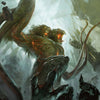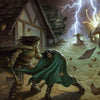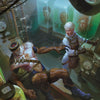How to Use Cliffhangers and Entanglements in D&D

Written by Luke Hart
Think about some of the very worst D&D games you’ve ever been in. What do they all have in common?
I don’t know about you, but the best way I can summarize a horrible D&D game is that after it ends, you have no real reason ever to go back; there was nothing exciting about the game session and nothing compelling you to return next week.
Sure, sometimes you have toxic game masters who do horrible things, and sometimes you have dysfunctional players running rampant, but those seem to be outliers. Most of the time, a bad, dead game is just a meh game. Who wants to spend four hours of their day in a completely forgettable game with nothing compelling about it?
Thus, I submit to you that the very best D&D games leave their players craving more, salivating at the thought of the next game session. That is, the players want to come back next week. If you can run games like that, your D&D games will become legendary.
So, today, I’ll share three things that you, as the game master, can do to hook your players, addict them to your game, and keep them coming back for more.
Watch or listen to this article by clicking the video below.
The essence of all three methods I’m going to share has to do with ending the game on a note that makes the players want to come back and find out what happens next.
Of the three ways you can hook your players and bring them back for more, two of them we shall classify as easy ways, and the third is the hard way. In my opinion, the hard way is the best, but, again, it isn’t easy to do. We’ll go over the two easy ways first and then touch on the hard way.
End the Game on a Cliffhanger
You probably already know what a cliffhanger is, but just to make sure that we’re on the same page, a cliffhanger is anything that leaves the players hanging on to find out what happens at the start of the next game session.
Here are some techniques you can use to implement a cliffhanger at the end of your game session.
The first way to implement a cliffhanger is to leverage combat. When combat is done right, it is one of the most exciting parts of the game for many players. Thus, using combat elements to generate a cliffhanger is probably the easiest way for a game master to leave the players wanting to know what happens next. Here are a few different ways you can do that.
#1 End the game right before a critical or important dice roll.
For instance, a fireball just went off, and every character must make a saving throw. Before they roll those dice, or near the end of a difficult fight, when the players have the boss on the ropes and the heaviest hitter, the barbarian, is about to take their turn, end the game.
Let’s say a character is about to make the final death save or recovery check that determines if their character lives or dies. Before they make that check, end the game. Ending the game this way is simply devious, and your players might be a little outraged that they don’t get to see what happens next. That is exactly what you want.
#2 End the game in the middle of combat right after something big happens.
This big thing could be good or bad, as long as it’s big. The bad guy just scored a critical hit on a character that’s near death, and the game master is about to roll for damage. End the game. The characters just took down the last minion, and now it’s just them and the final boss. End the game. A massive spell just took down half the party; they’re on the ground and dying. End the game. A character dies. End the game.
#3 End the game before the players roll the dice in an encounter.
Of course, this is the easiest way to use combat as a cliffhanger; however, unless this event coincides pretty close to your session end time, I would strongly recommend pushing forward and attempting to land #1 or #2 since those are much better cliffhangers.
#4 End the game before players can loot.
If combat ends before the game session is over, let the players bask in their victory for a few moments. Then, as soon as the first player declares they are going to check the monsters for loot, end the game. Don’t let them know what cool things they found on the corpses. Make them wait until the next game session to find out. I would suggest that you ensure that whatever they find is something cool enough to be worthy of a cliffhanger like that.
Now, that doesn’t mean you have to inject additional treasure into your adventure. Instead, maybe you can give them something they would have gotten later anyway. Of course, if you want to be really devious (and a little bit of a jerk), at the beginning of the next game session, when they’re all excited to find out what they got on the corpses, you could just tell them that there are a few copper pieces . . . or nothing at all. However, you’re only going to get away with that trick once.
#5 Reveal something unexpected or mysterious with immediate consequences.
This usually involves ending the game session after revealing something that will leave the players wondering what it could possibly mean or how it will affect their characters.
An Oracle may have just quoted a line of prophecy, for instance. Or the next door has a strange rune on it that harkens back to an ancient lost empire that the party has been investigating. Or they might open a door to discover that there is no room on the other side, and instead, the door is a gateway to another plane or location, but they don’t know quite yet where it leads. Or they meet a strangely eloquent troll who speaks in a refined British accent and doesn’t immediately attack.
You could also have an NPC say something ominous with immediate potential consequences. For instance, the characters have just arrived at an NPC’s abode and requested help for a strange affliction one of them has. The NPC tells them they’ve seen this curse before and that things are dire. But they must act quickly!
Or you have a shady NPC about to do something helpful, but they could easily turn on the party and make things worse. For instance, in an episode of the Glass Cannon podcast, Troy Lavalley used a line similar to this: “Always remember, my friend . . . this is the moment when you chose to trust me.” And then his players went crazy with paranoia.
#6 Subvert expectations.
Basically, you take a situation that the players think will be one thing and make it something completely unexpected. For instance, the players have been tasked with finding an ogre that has been harassing merchants on the road. When they finally encounter the ogre, he looks at them in fear and calls out, “Please! Gort need your help!”
Or the characters open the door to enter an ancient dwarven stronghold only to discover a massive crevasse where the stronghold should be. Peering into the crevasse, they can see what appears to be a gateway into the abyss.
Or the dark shadow of a dragon blocks out the moon over the character’s campsite. It turns to dive, but in the moonlight, they notice it has a mix of red and gold scales.
Now, you may be thinking, “Great. I know all of these cliffhanger techniques, but isn’t the real trick to be able to actually implement them? How do I make sure my game session ends with one of these cliffhangers? Do I plan for them?”
Well, you can, but it isn’t always the easiest thing to do. What I would do when planning for a game session is consider what will likely happen, where I might insert cliffhangers, and what those cliffhangers might be. Then, during the game session, just keep your eyes open and watch for opportunities. This, of course, will be toward the end of the game session.
I would say that during the last hour of a game session, I would be watching like a hawk for an opportune moment to introduce a cliffhanger. Then, once you stick that landing, end the game session and tell everyone they will find out what happens next time. This might mean, of course, that you’ll end your game session earlier than the scheduled time or a little bit later if that’s an option. But being flexible in this regard is the only real way to ensure that you can slip in a cliffhanger.
End the Game with Entanglement
An entanglement is similar to a cliffhanger in that it leaves something at the end of the game session the players will want to pursue. However, an entanglement doesn’t necessarily imply immediate resolution when the next game session begins. Simply put, an entanglement is any situation that makes the players eager to return without a specific end-game reason.
Here are a few different ways you can introduce entanglements at the end of a game session:
#1 Drop a big mystery that needs investigating.
The party is supposed to meet a contact in an alleyway, but when they arrive, they discover the contact’s body lying in a pool of blood. End the game. The characters discover an ancient tomb that tells of a powerful fountain lost in a nearby desert that can supposedly grant anyone who drinks from it one wish. End the game. A trusted NPC tells the party that their daughter has suddenly fallen ill with a sickness that can’t possibly be natural. End the game. Someone the party trusted with an important MacGuffin shows up at the inn beaten and battered to inform them that the item was stolen. End the game.
#2 Ominous foreshadowing.
A lot of authors use this method to hook readers. This essentially involves cutting to a short scene that the characters aren’t aware of but will find intriguing or foreboding.
A dark rider comes over a hill and approaches the city gates. The rider questions the guards about a party matching the characters’ descriptions. End the game. A monstrosity awakens in the dungeon that the characters just completed. It crawls out from beneath some rocks, brushes itself off, and looks into a small puddle of water to reveal the face of one of the characters. End the game.
The scene cuts to a rooftop across the street from the tavern, where the characters are recovering from their latest adventure as a light rain begins to fall. Lightning crackles and the momentary light reveals a shadowy humanoid form watching the inn. The lightning crackles again a second later, and the roof is empty. End the game.
#3 End on an exciting high note, especially after a huge victory.
There is a reason that adrenaline junkies exist. Excitement creates a natural high that people want to experience again. You want to celebrate these moments, not cast a shadow over them. End your game on this high note, and then let everyone start talking about all the cool moments that just happened. Players will be eager to recreate this experience, ending on a high note after a great victory in the future.
Run a Great Game!
Our previous two methods focused on how to end a game session, but the very best way to keep your players coming back for more is to simply run an amazing game. Of course, this is the most difficult way, which is why this website is full of tips on how to run great games.
In fact, I’m going to make a little bit of a confession here. I rarely implement all these ways to end the game with a cliffhanger or entanglement. I know that I should more often—and now that I’ve gone over them and publicly called myself out, I probably will. My games would be better if I did, but I often don’t. Instead, my players keep returning session after session because the game is enjoyable overall.
Sharing how to run a great game would fill hundreds of hours of text, but I’m going to leave you with five high-level thoughts on the topic:
#1 Find out what your players want out of the game, and then give them a lot of it. The easiest way to discover this information is to simply ask them.
#2 Let your players’ ideas influence the game. Show them that you want them to be a part of the campaign and that you aren’t the only one running the show.
#3 Use aspects of your players’ backstories to make them feel part of the world and the campaign.
#4 Reward the character’s actions and choices with positive, or at least interesting, results. Make their decisions matter.
#5 Regularly check in with your players and adjust your game according to their feedback. I have found that anonymous surveys work best for this.
Do You Sometimes Feel Overwhelmed as the DM?
When I was a new dungeon master, I was overwhelmed with everything I needed to do. Learn the rules, create the adventures, run the game, handle problem players—it was A LOT! And even as a veteran DM, it’s still a lot. You might even feel that way yourself.
If you’re looking for loads of 5e adventures that you can prep in under 30 minutes, or elements such as traps, puzzles, and encounters that you can drag and drop into your game at moment’s notice, we have you covered!
With Lairs & Legends and Loot & Lore, you’ll get over 700 pages of 5e resources:
- Twenty-nine 5e adventures spanning levels 1 to 15 and designed for groups of 4 to 6 players.
- Over 100 new creatures from CR 0 to CR 24.
- Adventure Ideas
- Encounters with Full-Color and Blackline Digital Maps
- Patrons & Factions
- Magic Items
- NPCs
- Puzzles
- Random Encounter Tables
- Random Tables
- Spells
- Subclasses
- Traps
- Villains
Everything is designed to be EASY TO USE and QUICK TO PREP for your game. Our goal is to make game masters’ lives easier, not more complex!
Don’t spend another moment frustrated and overwhelmed as a DM. Pick up the Lairs & Legends Ultimate Bundle today and find out how much easier being a DM can be!
-
Posted in
Game Master How-To Articles







